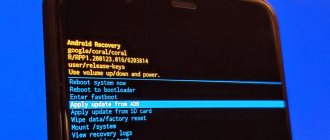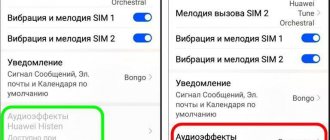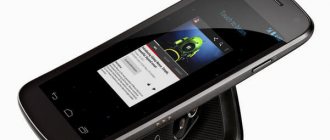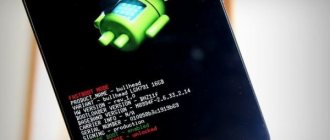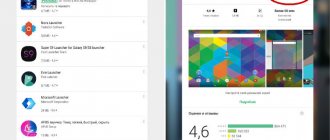How to enter Recovery on Huawei and Honor? The appearance of such a question usually indicates problems with the smartphone, since Recovery mode is designed to reset the current settings to the basic, factory level. Considering that such a reset will lead to the loss of all information stored on Android, it is used only in exceptional cases when other methods of solving problems do not help restore the phone's operation.
However, the mentioned mode also has other functions, so it can be used without unpleasant consequences. So, it can help with rebooting the system. True, you can turn on Recovery only after completely turning off the smartphone. That is, users will not be able to return the device to normal operation after freezing; for this purpose, other actions are provided to cope with the difficulties that arise.
What can you do in recovery mode?
- Install official, custom firmware, any archives with programs, for example, GAPS, programs for obtaining ROOT rights and much more.
- Perform a factory reset, delete the cache, clearing the memory of unnecessary “junk” and garbage.
- Back up data and then restore it.
- Mount and format specific partitions of the file system.
- wipe cache partition
Reset the application cache partition, it can help if the device becomes slow or applications do not work correctly - wipe data factory reset
Reset the data of all applications, in other words, do a Hard Reset (more details) - reboot to system
Reboot and go to normal mode, essentially exiting recovery
Preparing for a factory reset
Before you begin the recovery process, you should first take care of all the information stored on your smartphone. Because after the actions taken, it is impossible to return the lost data. What does the preparation consist of:
- turn off the gadget;
- The battery charge level at the time of shutdown must be at least 70%, since the process is energy-consuming, it wastes almost all resources;
- Performing a hard reset for a long time can cause the phone to freeze and not function, in which case removing the battery will help;
- make a backup copy of all files on your smartphone;
- The cache is cleared before starting, thus reducing the procedure time.
Now let's get down to the methods of restoring the original state.
How to save all data from your phone before resetting
Now it's time to gradually move on to a detailed consideration of the reset process. Since the operation leads to a complete clearing of the storage, we need to take care of the safety of personal data and files. In other words, create a backup copy.
Honor and Huawei phones offer several ways to create a backup. First, let's look at the one that is available on all Android smartphones. This is a temporary transfer of files to Google Drive cloud storage.
Please note that by default the amount of free space in the cloud is limited. If your backup exceeds the threshold, you will need to subscribe or use another method to save your data.
To create a copy using Google cloud storage, you need to open your smartphone settings, go to the “System” section and select “Backup and Restore”. In the proposed list, you will only have to activate the Google backup option.
After this, the process of creating a backup and uploading data to Google servers will begin. As soon as the copy is ready, you can safely proceed to resetting the settings. And if you don’t like this method of creating a backup, it is recommended to use HiCloud through all the same settings. This is another cloud service, but from Huawei. The corresponding item for downloading a copy is available in the device settings.
In conclusion, let’s consider another option that will be relevant for those who are not used to using cloud services. All personal files can be temporarily transferred to an external drive. For example, a MicroSD card. If this option suits you, then follow the following instructions:
- Open your phone settings.
- Go to the "System" section.
- Select "Backup and Restore".
- Click the "Backup Data" button at the top of the screen.
- Select an external drive as the copy source.
The process of creating a copy will take some time. You need to be patient until all the files are transferred to the external drive. The speed in this case will depend on the capabilities of both the internal and external memory of the smartphone.
How to reset settings on Android
In order to reset settings on Android, you need to activate the system recovery mode and select Hard reset in it. To perform a hard reset on a Chinese device, you must first copy all the important information to another device. Decoding of all recovery points is standard for most models - Lenovo, Samsung, Xiaomi.
Recovery allows the user to roll back the Android operating system to the factory version and clear all available memory of the smartphone. Using the Wipe data factory reset item, it is possible to save media files after resetting. System functions make it possible to restore the operation of the smartphone and remove unnecessary applications that cause crashes and errors. On Chinese phones, items are described in the manufacturer's language or in English. To decipher the points, you must follow the instructions, which are the same for most Lenovo (Lenovo) and Xiaomi models; for this reason, translation is not required.
On any device running the Android operating system, there is a special . Service specialists use it to test the operation of the smartphone and debug the installed software. An ordinary user resorts to Recovery services only in one case: when it is necessary to restore the phone to factory condition.
This operation is called Hard Reset
and is used in the following situations:
- It is impossible to restore the functionality of a device damaged by installing new firmware or applications by other means;
- Pre-sale preparation of the device is carried out.
note
A hard reboot completely deletes all traces of the user's presence: the contact database, the message archive, all saved files and installed applications. Therefore, before resetting the settings, you need to transfer useful information via a cloud service or simply to an SD card.
How to fix "software install failed" manually
Often the bug Software install failed! appears when updating Huawei devices manually. This result is often caused by cases where the gadget in standard mode does not notice the update, and the owner of the smartphone wants to switch to updated versions of the software.
- Download the desired update to your PC from official sources. There are many developers, one of the recommended ones is 4PDA - make your decision yourself. Archive volume is 2-5 GB.
- Create a “dload” folder and extract the UPDATE.APP file into it. Please note that there is often a downloaded directory with the necessary content, so it is available for extraction in its entirety.
- Check on your PC that the elements in the folder are available for opening and launching.
- Connect your Huawei smartphone via USB cable to your laptop or PC. Then drop the dload folder with all the files into the root of the smartphone’s SD memory.
- Disconnect from the computer and turn off the gadget.
- Press the volume buttons and the power button of the device at the same time. After 5-10 seconds of holding these keys, the smartphone will launch a forced update and flashing.
More about Huawei: Download Huawei MediaPad 7 Lite drivers - update Huawei software Manually flashing a smartphone
If you perform these steps correctly, if the error persists, check the following nuances:
From Android 6.0 onwards, the creators of the Huawei brand no longer give chances for updates via SD card and have stopped producing standard packages. If you have Android 4.2 or 4.4, then the best thing to do is download the official update to version 5, and then update over the air. Or pay attention to updates to standard firmware.
The main cause of errors in Huawei brand smartphones is an archive with broken files or inaccuracies when the user creates the dload folder on his gadget. To fix it, the best way is to perform all the steps again after checking the correctness of the downloaded archive.
Options for solving the problem
At the moment there are several options to solve the problem. They differ in the degree of complexity and the number of steps required to exit tablet mode in Windows 10. But almost all methods are effective. They help solve the problem and return your computer desktop to its normal appearance. These are the methods:
- Switch in the notification center. Windows 10 has an updated notification center. And it has tiles for turning on or off certain functions of the operating system. There you can also find a button to switch to tablet mode or turn it off.
- Options menu. It helps in situations where there is no toggle tile in the notification center for some reason. But the number of actions to turn off this mode increases greatly.
So, there are two ways to solve the problem. And now we will analyze both in detail. If you find the tile you want in the notification center, consider yourself lucky. And if not, then you will have to do a little work before removing tablet mode on Windows 10. So, let's look at the first option.
How to turn on a Huawei phone.
To turn on the Huawei hg8245h, p20, e3372h touch phone, you must do the following:
- Press and hold the Power key until the phone vibrates. - If the phone was turned on but the screen went dark, press and release the Power key to turn it on. - A lock image will appear on the screen; to unlock the screen, drag the lock icon or tap on it. - When prompted to enter a code, enter the PIN code from your SIM card. In most cases this is 0000 and press OK - wait until the phone starts up.
Note: The PIN code for the SIM card is located on a plastic card or in a package received when purchasing a SIM card at a mobile phone store. But be careful, if the PIN code is incorrect three times, you can activate the SIM card only through the PUK code, which is also included in the package received when purchasing the SIM card.
If the PUK code is lost, it can only be restored using the passport of a citizen of the Russian Federation for which the SIM card is issued. Therefore, do not enter your PIN incorrectly more than three times. If you have lost your PIN code and there is no way to recover it through your telecom operator, you can do the following.
Cancel the PIN code prompt when turning on your Huawei 701u, l21, g750 dual sim phone. To do this, find another SIM card with a PIN code you know (you can assign a PIN code in the settings) and insert it into your phone. Turn on the phone according to the steps described above, when entering the password, enter the PIN code you know from another SIM card.
After successfully turning on the phone, go to the phone settings and cancel the PIN code prompt when turning on the Huawei p10 - dpi phone. Having done this, turn off the phone and change the SIM cards. Now, when you turn on the phone, the system will not require you to enter a PIN code.
This is, of course, elementary advice, but there are solutions to more serious problems.
How to enter recovery on Android
Literally every person may need access to Recovery on Android. This menu is used to restore the functionality of Android devices, to format memory and much more. This mode is present in almost all smartphones and tablets, so accessing it will not be difficult. Let's figure out what Recovery mode is for and how to activate it.
What is Recovery on Android
During the operation of Android devices, various errors may occur in the operating system. Their appearance leads to a decrease in operating speed, as well as regular freezes. In the most difficult cases, smartphones and tablets lose their functionality - when turned on, the name of the phone or the Android logo (green robot) appears on the screen, but no further loading is observed.
In order to restore the device to functionality, you need to perform a general reset or clear the cache. A master reset is also performed through the user menu. If the operating system does not load, we will not be able to get to the desired function. In this case, you need to go to Recovery Mode and perform a complete reset using the “Wipe data/factory reset” item.
All data from the device will be deleted, after which it will be able to boot - then you need to perform the standard initial setup from scratch. If your smartphone is frozen, but you don’t want to lose valuable data, you can do it differently - delete the cache.
In some cases, this method gives excellent results, allowing you to restore the functionality of the Android operating system. There are also other functions in Android System Recovery:
- Reboot Android;
- Installing updates (for example, from an SD card);
- Installing the update via ABD;
- Installing updates from the cache;
- View recovery logs.
Depending on the smartphone/tablet model, there may be some other functions.
If you don’t know what a particular function in the Recovery Android menu is for, don’t try to select them at random - this can lead to the complete deletion of all data and other not very pleasant consequences.
In some models of phones and tablets, there is a flashing launch point here. You should not try to reflash Android devices yourself without having the appropriate experience to do so. If you got into the menu completely by accident and want to get out of here without unpleasant consequences, use the volume control buttons to select the “reboot system now” item and press the power key - the reboot will begin in normal mode (without data loss).
How to enter the Recovery menu on Android
In order to activate Recovery Mode on Android, you need to know the name and brand of your phone. If you don't remember the name of your original handset, find the box or look under the battery - you will find the information you need there. Next, we look for a key combination to enter Recovery Mode on specialized forums or in search engines. Here are the most common key combinations:
- For Samsung phones - power key, volume up key and Home key (center key);
- For LG phones – power key and volume down key;
- For Nexus phones - the power key and the volume down key, then select the desired item;
- For Motorola and Lenovo - power key, volume up key and home key;
- For Sony - press the power button and wait for the double vibration, then move your finger to the volume up button.
Please note that sometimes these combinations do not work. If you can't access Recovery on Android, look for the key combination for your phone model
The ADB Run program is also used to enter Recovery Mode. But you can use it only when the smartphone is operational and you have the opportunity to enable “USB Debugging”.
If all else fails, it means that your phone does not have Recovery Mode, and you need to install it separately - it is best to entrust this procedure to experienced users.
Instructions for installing Recovery are published on specialized forums dedicated to mobile devices. Please remember that such interventions often void the warranty.
How to use the new functionality
To update Huawei firmware in this way, you must initially meet two important conditions:
- The smartphone battery should be as fully charged as possible. That is, it is recommended to initially charge the gadget;
- The mobile phone must have the correct Wi-Fi settings, allowing the phone to easily connect to a wireless network.
If everything is fine with these points, you can proceed with the upgrade. How to do it:
Then the phone begins to search for available Wi-Fi points. Will offer a list of available ones. Naturally, you need to choose the one that the owner of the smartphone constantly uses. Next, enter the password and wait for the result.
Attention! In some situations, the connection is interrupted at the moment and the error Getting package info failed appears on the screen (we wrote about its solution here). If this does not happen, then the smartphone will independently find the necessary and suitable firmware, download and install it.
What is Recovery Mode and what is it for?
Recovery Mode or recovery mode is a special mode designed to restore the functionality of the iPhone. This feature will come in handy if a critical software error occurs, the device malfunctions, or an unsuccessful Jailbreak.
However, do not confuse a software problem with a frozen iOS loading indicator. Often this process slows down due to writing or reading a large number of files. It may seem that the device is frozen, although it is not. You can check the functionality of your iPhone by pressing any button. In this regard, when updating/resetting the device, you should not use Recovery Mode.
Ask your question to a specialist
Don’t know how to solve a problem with your gadget and need expert advice?
Recovery mode should be used in the following cases:
- iPhone won't boot or hangs at the apple icon with no loading indicator
- The screen displays "Connect to iTunes"
- iTunes does not recognize iPhone correctly
Installing custom firmware on Huawei P10 Lite firmware
Installing custom firmware on Huawei P10 Lite via TWRP recovery To install firmware using this method, TWRP recovery must be installed on your Huawei P10 Lite; if this is not done, you can install recovery according to the instructions above.
Download any custom non-official firmware for Huawei P10 Lite in *.zip format, for example:
AOSP_hi6250-8.1.0-OPM4 or RessurectionRemix-O-v6.0.0-20180424
and copy it to the internal memory of the smartphone in the root folder.
We reboot the smartphone into TWRP recovery (Turn off the device. Press the volume up and power keys until they vibrate, release and wait for entry.), and there we go to the “install” menu, then select the custom firmware file for Huawei P10 Lite and swipe to the right to start the firmware process.
The firmware installation process usually lasts a couple of minutes (the time depends on the size of the firmware); when the firmware is finished, reboot the phone.
That's it, good luck.
Share link:
- Click to share on Twitter (Opens in new window)
- Click here to share content on Facebook. (Opens in a new window)
- Click to share on Telegram (Opens in new window)
- Click to share on WhatsApp (Opens in new window)
- Click to share on Pinterest (Opens in new window)
- Click to share posts on Tumblr (Opens in new window)
- Click to share on Reddit (Opens in new window)
- Click to share on LinkedIn (Opens in new window)
- Click to share on liveinternet (Opens in new window)
- Click to share on Livejournal (Opens in new window)
- Click to share on Webmoney (Opens in new window)
Cannot exit recovery mode reasons and what to do
There are situations when the iPhone cannot exit recovery mode. This situation is called Recovery Mode Loop. Its appearance is due to the fact that during recovery a complete diagnosis of the system is performed. If errors occur, the iPhone starts the Recovery Mode procedure again and so on ad infinitum. The reasons for the appearance of Loop are most often associated with software errors. For example, with installation interruption.
A similar situation is also possible when trying to roll back to a lower version of the system. Most often, Apple closes this option and downgrading is not possible. But in exceptional cases, Cupertino allows you to rollback (iPhone 4S and iPad 2). You can check your iPhone for supported iOS on the website.
Increase
You can exit recovery mode through iTunes. You should connect your iPhone to your computer and see if the device is detected. If yes, then restore your smartphone. Please note that as a result of this procedure, all user data will be erased and the latest version of iOS will be installed on the device.
Increase
If you couldn’t exit Recovery Mode using iTunes, then you need to use third-party programs. Their functionality is largely similar; we will look at the Reiboot application. It allows you to both enter and exit recovery mode. This is all done with one button, and you just need to connect your iPhone to your computer. The advantage of using third-party utilities is saving data on iPhone.
Increase
Exit Recovery Menu
In some versions of recovery mode (especially in gadgets from unknown Chinese companies), the text of menu items may have slight differences. Therefore, we don’t worry and look for an item that offers a reboot system without verbose additions. In the standard version, this item looks like Reboot System Now.
Sometimes, even after a reboot, the device may start again in recovery mode. This is a warning sign that may indicate serious hardware problems. But sometimes the normal mode does not start due to minor problems that are easy to fix.
Try one of the following emergency options:
- Press and hold the device's start button for at least ten seconds. This is similar to pressing the restart button on a frozen computer and solves most problems by resetting the settings, returning you to the recovery screen.
- Remove the battery, wait a few seconds, and put it back in.
- Disconnecting from the power source is also perceived by the gadget as a large-scale reboot.
- Wait until the device is completely discharged and try to turn it on again, recharging the battery a little.
- Connect the equipment to your computer and reset it using ADB RUN or another similar program.
Recovery in Chinese
Devices made in China are equipped with a system menu in the manufacturer's language. For ease of use, you need to compare the recovery menu items in Chinese with standard items that are identical in content and set of functions.
To call the recovery menu you need to:
- Power off the device
- Press and hold the power and volume up keys at the same time
- Holding the buttons will turn on the device and display the required mode
The user can move up and down through the settings using the volume buttons; to select a specific action, use the home button.
The main sections of the recovery system menu in Chinese correspond to the standard translation:
- Auto Test – checking the basic parameters of the operating system and testing it for errors
- Wipe eMMC – hard reset of all parameters and settings of the smartphone without the possibility of recovery
- Reboot - reboot
- Version info – help
- Mounts with Storage – gadget memory management, information about the amount of free space or formatting
- Wipe Cache Partition - clearing the cache
- Wipe Cache Partition – copying all existing information
- Factory Reset - restoring factory settings
To exit the settings, just press the power off button.
To restore the device to factory settings, perform a hard reset. This item can be accomplished in two ways - in the menu and, for cases when the smartphone does not turn on, using a key combination. Hard reset on a Chinese phone in the menu is convenient to use only if the items are configured in Russian:
- Select "Settings"
- Activate "Backup and Reset"
- Additionally, click on “Reset settings”
For those cases when the device does not turn on or the Russified menu is not available, a hard reset on a Chinese phone is performed through rakveri or by pressing the “Power” + “Home” + “Volume Down” buttons, then select wipe.
Performing a hard reset will delete all the user’s personal data from the gadget’s memory.
Resetting the settings on a Chinese device Wipe data factory reset allows the user to clear the cache, remove installed applications and errors caused by their operation, while saving media files - music, photos, images.
You can call up the recovery menu on Android OS on a Xiaomi device by following the standard sequence of actions. Turn off the smartphone, then simultaneously hold down the volume up, home and power buttons. The volume up/down buttons are used to move through items, the power key is used to select or activate one of the actions. In this mode, it is possible not only to return to factory settings or restore functionality, but also to update the TWRP, CWM system folders.
On Android, in the system recovery menu you can not only reset, but also test the phone’s operation in the Factory mode item. It is represented by several subparagraphs, deciphering their meaning in Russian:
- Full Test – all phone parameters are checked
- Item Test – custom scan
- Signaling Test – SIM card and signal level test
- GPS – diagnostics of the correct operation of the location system
Supported Huawei data recovery devices
HUAWEI Data Recovery Tool - Android Data Recovery can be used to recover lost or deleted data including photos, contacts, messages, call logs, videos and many other files from Huawei phone and SD card. This HUAWEI Android data recovery tool can recover data when deleted, formatted or lost after factory reset, OS update, rooting, etc. It supports almost all HUAWEI phones and tablets:
Huawei Mate: Huawei Mate 20 / Mate 20 Pro, Huawei Mate 20 X (5G), HUAWEI Mate 20 RS Porsche Design, HUAWEI Mate RS Porsche Design, Huawei Mate 10 / 10 Pro, Huawei Mate 10, MNATEX MATEX XUMUMX, MNATEX MATEXEUMEX, MATEX XUMUMX, Huawei Mate 10 Pro, Huawei Mate 9 Porsche Design, Huawei Mate 9, Huawei Mate 9, Huawei Mate S and Huawei Mate RS Porsche Design.
Huawei P: Huawei P40 / P40 Pro, P40 Pro, Huawei P30 / P30 Pro, Huawei P20, Huawei P20 Pro, Huawei P10, Huawei P10 Plus, Huawei P9, Huawei P9 Plus, Huawei P8, Huawei P8max, Huawei P8 Lite, HUAWEI P smart 2021, HUAWEI P smart 2021, HUAWEI P smart
Huawei Honor: Huawei Honor V9, Huawei Honor 8, Honor 8 Pro, Huawei Magic, Huawei Honor 7/6, Huawei Honor 6, Honor 6X, Huawei Honor 5X, Huawei Honor 4c/3c, Huawei Honor 4x
Huawei Nova: HUAWEI nova 5 Pro, HUAWEI nova 5, HUAWEI nova 5i Pro, HUAWEI nova 4 / nova 4e, nova 3 / nova 3i, nova 2s, Huawei Nova Xova, Nova Nova
Huwei G: Huawei G9, Huawei G9 Plus, Huawei G9 Lite, Huawei G8, Huawei G7 Plus, Huawei GR5 2021, Huawei GT3, Huawei GR5, Huawei GR3, Huawei Ascend G
Huawei Y: HUAWEI Y9 Prime 2021, HUAWEI Y7 2021, HUAWEI Y9 2021, HUAWEI Y6 2021, HUAWEI Y5 2021, HUAWEI Y6 Prime 2021, HUAWEI Y6 2020, HUAWEI Y9 2021, HUAWEI Y5 Prime 2021, Huawei Y5 2021, Huawei Y6II, Huawei Y5II, Huawei Y3II, Huawei Y6 PRO
Ascend: Huawei Ascend P8, Huawei Ascend G7, Huawei Ascend Mate 7, Huawei Ascend Mate 6
Other Android phones and tablets: Samsung Galaxy, LG, HTC, Sony, Google Pixel, Nexus, OnePlus, Motorola, Xiaomi, Redmi, Oppo, Meitu, Windows Phone, Sharp phones and more.
This Andriod data recovery can be installed in multiple languages including German, English, Japanese, French, Portuguese, Spanish and Italian depending on your condition.
Free download HUAWEI Android Data Recovery for Mac and Windows and try it now:
What kind of animal is this
What does Android System Recovery 3e mean? This is a kind of BIOS of a mobile device. Any operating system has its own BIOS - a basic input/output system that can work even if the main OS is damaged. Sometimes the BIOS is different from the standard one (as, for example, in Android devices). It is used to restore the functionality of a smartphone or tablet, apply critical updates or reset to factory settings. The Android System Recovery 3e menu has many items that correspond to one or another action. But the trouble is that the names are written in English. Therefore, many people do not even know how to use recovery correctly.
That is why this article was written. Android System Recovery, the instructions for which are absolutely necessary, is a powerful tool for setting up and resuscitating a smartphone. You need to know everything about how to use this recovery in order not to waste money on specialists. Doing everything yourself is much easier and cheaper. We will analyze each item in the recovery menu and tell you everything we can about it. So let's begin.
Telephony
One of the main points that catches your eye when you first enter the engineering menu of an Android Huawei smartphone is the telephony menu. In this menu you will have access to many useful settings, including such important items as:
- Auto Answer. Here you will be able to enable or, conversely, disable auto answer to an incoming call.
- Band Mode. Here you can manually select frequencies for the GSM module. This menu will show you all the frequencies your phone supports. You can uncheck those bands that your mobile operator does not provide, which will ultimately save your battery power.
- CFU Setting. This option enables or disables conditional call forwarding.
- AT Command Tool. A utility for developers that supports AT commands.
- Modem Test. Fine-tuning compatibility with different types of devices.
- Network Selecting. Here you can also select mobile communication standards (GSM, WCDMA, LTE). For greater energy savings, turn off those not in use.
- NetworkInfo. A very convenient option for checking the quality of mobile operator services.
- GPRS. Setting up mobile internet connections. A choice of active SIM card is also available.
- HSPA Info. Information about the 3G network if this type of service is supported by your telecom operator.
- Mobile data service preferred. Using this item, you can increase the priority of the Internet over voice traffic. However, be careful, as incoming calls in this case may sometimes not reach you.
- Fast Dormancy. Allows you to save some of your phone's energy on third generation networks.
- RAT Mode (Phone Info). Using this menu you can select the most used communication standard. However, use with caution, as these settings block the action of the Network Selecting item.
- RF De-sense Test. Selecting a frequency range and a specific channel for testing communication quality.
- SIM ME Lock. Makes it possible to configure the regional parameters of the GSM module in manual mode.
More about Huawei: @kompr: Well, the fake about Hunter Biden’s “emails” didn’t last even three days
Modern custom Recovery
TWRP
The youngest of all three Recovery. It only has a touch interface, but it also provides a separate view for tablets (see screenshots). The touch interface is self-sufficient and is not a kind of add-on over the text interface (like CWR and 4EXT), which in my opinion is more convenient
Particular attention is drawn to the element for confirming any operation - it is designed in the form of the famous “slide to unlock”. In general, using the TWRP interface is noticeably more convenient than that of its competitors
And I haven’t yet mentioned the changeable design themes, which can affect not only the appearance, but also the functional arrangement of elements. Among the functional differences is the ability to select partitions saved in the backup, and, in addition to the standard ones, you can add a backup copy like this - You can also add a cache and Recovery itself. I was also very pleased with the ability to immediately specify a name for the backup archive - very convenient. For example, I gave the original firmware the name “original”, which allows me to skip it when clearing backup copies of unnecessary ones without specifically looking for them among similar names. Repeating the words from teleshops, “but that’s not all” - the backup copy can be compressed (takes up less space, but at the same time it takes significantly longer to create) and disable the generation of MD5 sum (it is created faster, but if the archive is damaged, this will not be detected ). It is also worth mentioning that when creating a backup, TWRP immediately, even before starting, shows the amount of memory occupied by the partitions, as well as the free space on the drives. In general, when it comes to backup/restore, TWRP is head and shoulders above CWR and 4EXT, which is good news. Just like 4EXT, this Recovery allows you to mount a memory card like a drive to a computer without switching to the firmware. Moreover, this is done even on SGS3, where full-fledged firmware cannot, without special crutches, connect a flash drive as a regular drive, and not via MTP. What’s also notable about this recovery is its support for full disk encryption technology, which can protect your data if your phone is lost. However, it is quite possible to bypass it, so you still shouldn’t store any particularly valuable information on your smartphone, at least in open form. Nevertheless, this is a significant advantage of this recovery for those who care about the security of their data.
TWRP on Smartphone
TWRP on Tablet
In general, this recovery is perhaps the best that exists at the moment: convenient, functional, completely free. Highly recommend. I almost forgot - when creating an archive with a backup copy, this miracle of programming thought is capable of using several cores of your smartphone - which has a very positive effect on the speed of operation.
Installed using the GooManager application (MENU => Install OpenRecoveryScript)
Download free version
More details about firmware versions:
So, let's take a look at the firmware numbering of Huawei smartphones. For example, let's take the firmware from Huawei Ascend Mate - MT1-U06 V100R001C00B907.
As you probably guessed, MT1-U06 is the name of the device. MT1 is the main base, that is, Huawei Mate, U06 is a revision of the device. Devices come in different revisions, in this post I will not go into details of their designation, I will only say that the letter U is UMTS (regular 3G), and the letter C is the CDMA version. Devices with revision MT1-U06 are supplied to Russia.
CxxBxxxSPxx - This is the most important option in the firmware, it shows which version of the “base” the firmware is built on. Bxxx - the numerical class of the base for the SPxx firmware - Service Pack number. The higher Bxxx and SPxx, the newer the firmware. (Bxxx has higher priority than SPxx). Cxx is a region of the country.
Next, let's look at the firmware version itself - V100R001C00B907. V100 and R001 are the main version and firmware revision. They change in very rare cases, when there is a big change compared to the previous firmware version (for example, the transition from Android 2.x to 4.x). Even within Android 4.x versions, these values usually do not change.
C00B907 - for most new devices, the value of C00 no longer changes, and in general it means binding to the region. Now the region can be determined in the “Special version” menu item - CUSTC10B907.
So, for smartphones, the Russia region (channel/ru) is CUSTC10. The binding to the region can easily be changed with a special firmware file; in some official firmware there is an update.app file in the cust folder weighing several megabytes or kilobytes, which changes the region to Russia.
B907 is the firmware version itself. I think there is no need to explain that the higher it is, the newer the firmware.
Using TinyUmbrella and RedShow
For the TinyUmbrella program to work correctly, the NET Framework 3.5 and Java must be installed on the computer, otherwise the application will not start in the Windows environment. Once the program is running, you need to perform three steps:
- Connect iPhone/iPad to computer.
- Select the device in the left window of TinyUmbrella.
- Click “Exit Recovery” in the right window.
The device should work normally after rebooting. If TinyUmbrella did not help solve the problem, use the RedSn0w program:
- Launch the utility. You will see two buttons - click "Extras".
To exit recovery mode, select “Recovery fix”.
In the notification that appears, click "OK". The device will reboot and then start in normal mode.
If, after using the listed programs, the iPhone boots into recovery mode again, this indicates that it has entered an endless Recovery Mode. The only way out in this situation is to restore the device through iTunes.
Free consultation! Free diagnostics! Work guarantee!Select section:
| Repair iPhone | iPad repair | iPod repair | MacBook repair | iMac repair |
We can repair all Apple equipment
If you have a backup copy of your data, then nothing bad will happen: you will return the information to your iPhone or iPad after a full reset.
Message This cable or accessory is not certified...How to sync iPhone notes with Google or YandexiPhone X/8/7/6/ does not flip the image. Reason: How to disable iPhone's constant passcode request
What is Hard Reset
Hard reset – forced clearing of all information on the device to remove all installed programs, linked accounts, and user data. Hardware cleaning is most often required if there are any stutters or bugs in EMUI and Android in general.
A hard reset deletes all user data:
- Linked accounts;
- SMS messages;
- Saved passwords;
- Huawei account;
- Photos, videos;
- Audio files;
- Programs, games;
- Other information.
After using a hard reset, the phone turns into an out-of-the-box device. After this, you can re-enter Google Play, install the necessary programs and use the gadget as usual.
Useful tips
- The first thing we'll notice when we change our desktop to Continuum is the change in the Start menu. It automatically switches to full screen. Application buttons and individual notification area elements are no longer visible in the taskbar. Buttons are now separated by large empty fields, making them easier to hit with your finger. With all this, the Start menu remains the active desktop, and its interface is often compared to the iPad.
- Launched applications expand to full screen, but window headers are not so easy to see - to view them you need to move the cursor to them.
- If you no longer need an application, you simply pull it down and release it - it closes.
- For ease of switching between applications, there is a “Back” button located in the taskbar. For the same purpose, it is convenient to use the Task View.
If you want to use two applications at the same time, use the pinning feature. Its essence is that you move the window of one of the applications to the right or left border of the display. It remains there, and in the meantime you choose the second one. Very convenient: in front of you there are two windows, the size of which can be changed as needed.
Now we know how to enable and disable Windows 10 tablet mode on a laptop or tablet, we know how to use it and know about its benefits. We welcome your comments on this topic!
Using custom Recovery
The stock recovery mode has somewhat limited capabilities, which in some cases are simply not enough. So, you won’t be able to reflash your smartphone using it or install the required application from a memory card. Therefore, advanced users replace the standard Recovery with a custom one (CWM or TWRP), which is equipped with more advanced functionality.
As an example, let's look at the installation procedure and subsequent use of ClockWorkMod (CWM) Recovery:
The installation of Android CWM Data Recovery will begin. This process will not take much time. After it is completed, you can enter the custom recovery environment using the same keys that were used to load the stock Recovery.
In addition to the standard set of tools, the new resuscitation area will be supplemented with the following functions:
Having figured out how to work with the Recovery environment, you can flash smartphones or tablets, reset settings, create restore points and perform other specific actions without third-party help.
Dear site reader! Dear Android OS user!
The Android operating system has one “secret” mode that allows you to do non-standard operations in some non-standard situations
I mean Recovery Mode, which is recommended to be used with caution (!). Because how can you not restore, but on the contrary, seriously damage the system if you have a bad idea of what you are doing?
Therefore, entering this mode is not done in an obvious way and differs for different models.
So, Recovery
or
Recovery Mode
is a special device boot mode that allows you to restore the system or install updates for it.
It starts with the system completely turned off (!)
device using the combination of mechanical keys
Home + Volume Up + Power
for Samsung,
Volume Down + Power
for Nexus.
Here the “ +
” sign means the following procedure: you need to press the first key, then,
without releasing it
, press the second and,
without releasing the first two
, press and
hold
the third.
After the product logo appears, you need to release the Power
and continue to hold the others until you enter the mode.
In general, the key combination specific to your manufacturer may be different, so I would advise checking it before experimenting.
Unlocking the bootloader of Huawei P10 Lite
Get an unlock code on the Huawei website or for a fee on other resources.
Enable “factory unlocked” (FRP unlocked) in the settings for developers or disable the PHONE SEARCH function from Huawei on Chinese firmware.
Download and install the minimum version of ADB-setup on your PC. Open CMD in the ADB (command prompt) folder by pressing Shift + right click, from the options select “Open command window”.
Put your smartphone into Fastboot/Rescue mode and connect it to your PC. To do this, turn off the phone, hold down the volume down button and connect the USB cable.
On a PC, in the command prompt window, enter the command
fastboot
and then
fastboot oem unlock {your received code}
without {} signs.
